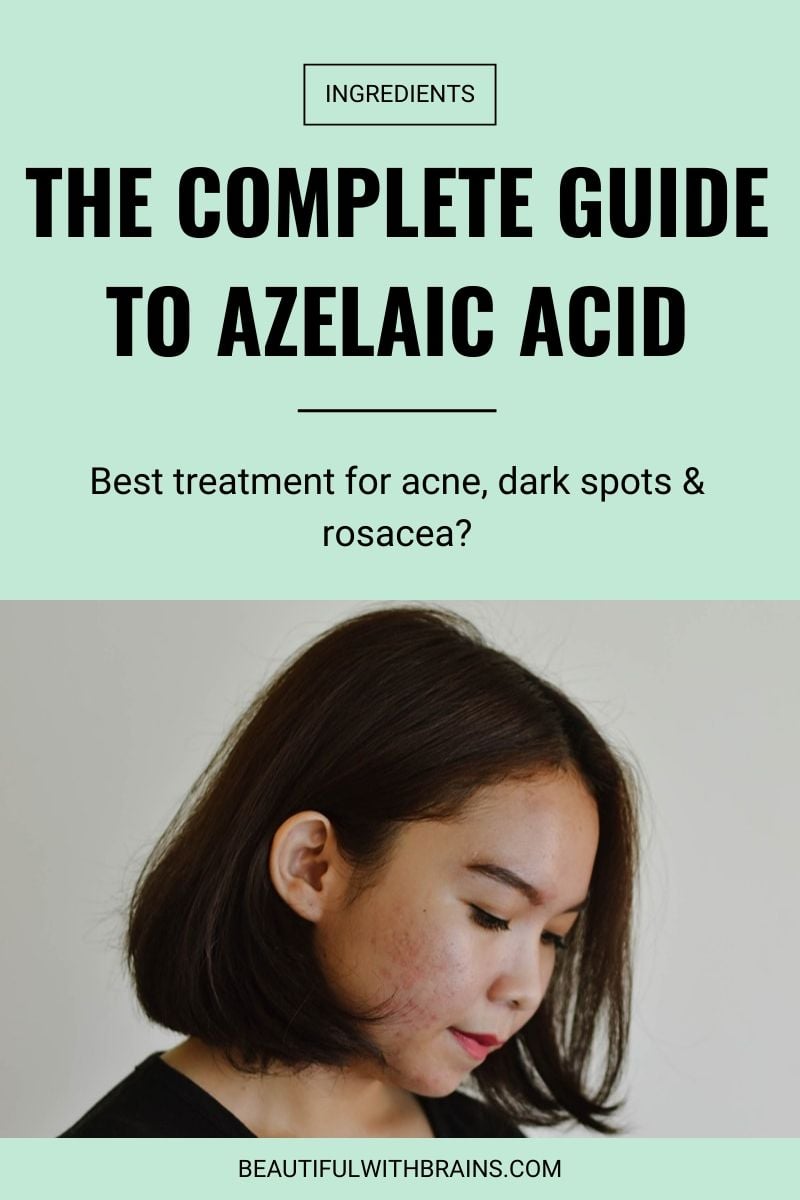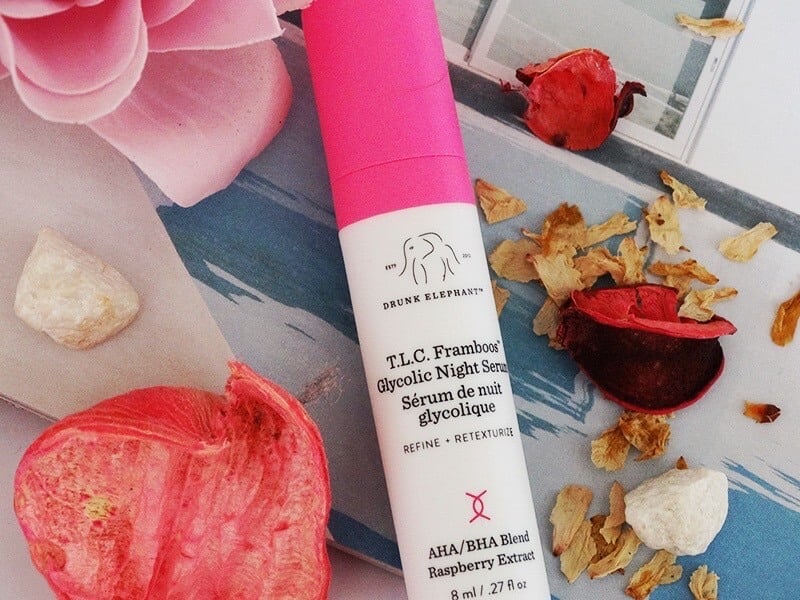
Why don’t more people know about Azelaic Acid?!
This little gem has been dermatologists’ best-kept secret for decades. They’re using it to treat all kinds of skin problems, from stubborn dark spots to inflamed cystic acne and unpredictable rosacea.
It’s one of those rare ingredients that does the job without irritating skin and leaving it a red, flaky mess. Even sensitive skin can use it.
And it’s finally making its way onto the virtual shelves of our favourite skincare stores. Should you grab a bottle, pronto?
That depends. Here’s everything you need to know about Azelaic Acid in skincare: what it is, what it does, and who should use it:
- What Is Azelaic Acid?
- Can Azelaic Acid Treat Acne?
- Can Azelaic Acid Treat Melasma, Hyperpigmentation, And Dark Spots?
- Can Azelaic Acid Treat Rosacea?
- Is Azelaic Acid An Effective Exfoliant?
- In What Concentrations Is Azelaic Acid Effective In Skincare Products?
- Should You Use Azelaic Acid?
- What Are The Best Skincare Products With Azelaic Acid?
- How To Use Azelaic Acid
- Does Azelaic Acid Have Any Side Effects?
- The Bottom Line
What Is Azelaic Acid?
Azelaic acid is derived from grains, such as barley, wheat and rye. It’s also made by the healthy bacteria that live on your skin.
Still, few brands use it because it’s tricky to formulate with. Do it wrong and you’re left with a grainy texture no one would touch with a 10 foot pole, let alone put it on their skin.
But, if you do it right, your skin is in for a treat. Here’s how it benefits skin.
P.S. Azelaic Acid has a trade name: Azalex.
Can Azelaic Acid Treat Acne?
Yes, yes, yes! Azelaic Acid is an effective treatment for all kinds of acne, including:
- Bacterial acne
- Big and painful “under the skin” pimples
- Fungal acne
- Anti-bacterial: It reduces P.Acne, the bacteria that gives you bacterial acne. The best part? Bacteria don’t grow resistant to it.
- Anti-inflammatory: Acne is an inflammatory disease. When you reduce inflammation, you heal it faster.
- Anti-keratinizing: A fancy way of saying it prevents the build-up of dead skin cells, so they can’t fall into your pores and give you breakouts.
- Reduces fatty acids content: Fatty acids keep your skin soft and supple. But too much of the wrong kind can feed acne. By reducing them, Azelaic Acid creates an inhospitable environment for bacteria and fungi.
Great! But, how does Azelaic Acid compares to traditional – and harsh – acne treatments, like Benzoyl Peroxide? Here’s what the research shows:
- Azelaic Acid vs. Benzoyl Peroxide: Studies show that 15% Azelaic Acid is as effective as 5% Benzoyl Peroxide. When used daily for 4 months, they both reduce acne by 70%! But Azelaic Acid does the job without the irritating side effects of Benzoyl Peroxide.
- Azelaic Acid vs Tretinoin: Research shows that 20% Azelaic Acid works as well as 0.05% Tretinoin, but without the same harsh side effects.
- Azelaic Acid vs Accutane: This time Accutane has the advantage, but only slightly! One study done on 85 participants shows that 20% Azelaic Acid completely cleared up their cystic acne, reduced whiteheads and papules by 88%, and clogged pores by 70%. Accutane completely cleared cystic acne, too. Plus, it reduced whiteheads and papules by 97% and clogged pores by 83%. Still, when you consider that Accutane is the most powerful acne medication in the world – and has severe side effects that require monitoring by a dermatologist -, Azelaic Acid still looks like the better option.
If you’re looking for a gentler way to treat your acne, or want to exhaust all options before trying Accutane, give Azelaic Acid a go.
Related: Adult Acne: Why It Happens And How To Treat It
Want an affordable skincare routine for acne that works? Subscribe to my newsletter below and receive The Ordinary Acne Skincare Routine Cheatsheet (it includes product recommendations too):
Can Azelaic Acid Treat Melasma, Hyperpigmentation, And Dark Spots?
Hyperpigmentation happens when your skin produces too much melanin (the pigment that gives skin its colour). It looks liked darker patches of skin here and there.
What causes it? Hormones. Pregnancy. Unprotected sun exposure. Age. Heck, even pimples can leave dark spots behind.
The gold standard treatment for hyperpigmentation is hydroquinone. There’s no doubt it works. But it’s not without side effects. It can cause dryness, irritation, and even permanent blue discolouration in darker skin tones.
Hydroquinone is so harsh, some countries have banned it altogether. In others, you need a prescription to get your hands on it. In the US, you can find it OTC, but only in concentrations up to 4%.
Enter Azelaic Acid. A 2011 study shows that twice daily application of 20% Azelaic Acid may be more effective than 4% Hydroquinone – and has none of its harsh side effects.
This study is not without its shortcomings (it was an open trial). But other, better structured studies, support these findings. Again and again, research shows Azelaic Acid works as well as Hydroquinone at treating melasma and hyperpigmentation.
Related: Does Hydroquinone Cause Cancer?
Can Azelaic Acid Treat Rosacea?
Rosacea is a chronic skin condition that’s often misunderstood for acne. Symptoms include facial redness, dilated capillaries, erythema and, sometimes, pimples and whiteheads.
The worst part? It’s very hard to treat… or even just keep under control. But Azelaic Acid is up to the job.
The same properties that bust acne make Azelaic Acid an effective treatment for papulopustular rosacea (the type of rosacea that looks like acne).
Studies show that 15% Azelaic Acid significantly decreases erythema and inflamed lesions in 6 months. Nothing works overnight, ladies! But, you can speed up healing by using it with antibiotics.
Related: How To Deal With Rosacea

Is Azelaic Acid An Effective Exfoliant?
Most people think Azelaic Acid is an exfoliant. Like Salicylic Acid (BHA) or Glycolic Acid (AHA). That’s sort of true… But it’s not the whole story.
If properly formulated, Azelaic Acid has an exfoliating effect. But it’s not as powerful as other acids out there. So, don’t throw your Salicylic Acid serums out just yet.
Instead, use them together. Some Azelaic Acid products contains exfoliating acids, too, to supercharge their performance.
Plus, as you know now, Azelaic Acid benefits skin in ways exfoliating acids can’t.
Related: AHAs VS BHA: Which One is Right For You?
In What Concentrations Is Azelaic Acid Effective In Skincare Products?
Most of the research on Azelaic Acid was done on prescription products that use a 15-20% concentration. But that doesn’t mean that it’s useless in smaller doses.
If you’re just starting out with Azelaic Acid or only have mild acne or discolourations, a 10% dose is more than enough to see results.
But if you’re dealing with more severe concerns – think cystic acne or stubborn dark spots -, it’s best to see a dermatologist and get higher, prescription-only concentrations.
Related: Stages Of Acne: How Severe Is Yours And How Do You Treat It?
Should You Use Azelaic Acid?
If you have sensitive skin and are dealing with acne/dark spots/rosacea, Azelaic Acid is a must.
If you’re dealing with these conditions and your skin isn’t sensitive, but you still want to use the gentlest treatment you can find, switching to Azelaic Acid makes sense.
If you’re not dealing with any of these issues, you DON’T need Azelaic Acid. You don’t achieve clear, flawless skin by using what’s popular. You get it by using what’s right for you.
What Are The Best Skincare Products With Azelaic Acid?
- Facetheory Azeclear Azelaic Acid Serum A15 (£24.99): Available at Facetheory
- Paula’s Choice 10% Azelaic Acid Booster ($36.00): Available at Dermstore, Net-A-Porter and Paula’s Choice
- The Ordinary Azelaic Acid Suspension 10% (£5.50): Available at Asos, Beauty Bay, Cult Beauty and Feel Unique
How To Use Azelaic Acid
First off, do a patch test first. Azelaic Acid is gentle, but you want to make sure that it (or anything else in the formula) won’t irritate your skin.
All good? Great! Apply a pea-sized amount of Azelaic Acid on affected skin after cleansing. If it’s a bit too harsh for you, try applying it on top of your moisturiser instead. It’s usually better tolerated this way.
PRO TIP: Opt for gel formulas whenever you can. They petter penetrate your skin and give you better results.
Related: How To Introduce New Skincare Products In Your Routine The Right Way
Does Azelaic Acid Have Any Side Effects?
Azelaic Acid is very gentle and well-tolerated even by sensitive skin. That’s what makes it such a good alternative to traditional acne, rosacea, and hyperpigmentation treatments.
But, everyone’s skin is different. In some rare cases, Azelaic Acid may cause dryness or sting a little upon application. But it’s still better than its harsher alternatives (trust me, if Azelaic Acid bothers you, anything else will destroy your skin).
P.S. Azelaic Acid is naturally present in your body, so it’s considered safe during pregnancy, too.
The Bottom Line
Azelaic Acid is a gentle, yet effective treatment for acne, rosacea, and hyperpigmentation. It works just as well as traditional, harsher remedies – but without their side effects. For sensitive skin, it’s a must-have.


Thanks for the info, I didn’t knew that
.-= Tavia´s last blog ..Review – La Prairie Cellular Eye Contour Cream (24 Hour Age Fighting Eye Care) =-.
You’re welcome Tavia!
How should we choose between whether to use azelaic acid or BHA/salicylic acid?
E, if you have hyperpigmentation, go with azelaic acid. Also, if salicylic acid isn’t helping your acne, you may need to switch to salicylic acid. In all other cases, salicylic acid will do just fine.
In your comment on 7/21/18 under a column about azelaic acid, you said: “if salicylic acid isn’t helping your acne, you may need to switch to salicylic acid.” I assume you meant to say you may need to switch to azelaic acid? Please confirm. Thanks!
MT, oops my bad! Yes, I meant Azelaic Acid.
Hello Gio!
Can azaelic acid be used for lightening dark skin areas like knuckles, knees etc.? I have some some lightening products formulated with azaelic acid alongwith or without licorice extract. What is your view on that?
Thanks!
Ana, yes, you can use them. 🙂
What product do you recommend that has Azelaic Acid? Daughter has Melsama on her face. Going to have her use PC Resist Triple Action Dark Spot for 4 months, then switch to Azelaic Acid. But what product is that or do we have to get it from a dermatologist? Thank you
Jean, you can get it OTC. Both The Ordinary and Paula’s Choice have azelaic acid products that can help.
can I use the ordinary azeliac acid and a toner with 5﹪Glycolic acid in at the same time?
Lily, it depends on how sensitive skin is. Some people can tolerate both, others need to alternate them on different days.
Azelaic acid has changed my life!! Possibly a little overly dramatic, but seriously, azelaic acid has been a total game changer for me. Nightly use of salicylic acid plus azelaic acid has completely transformed my skin. I used to suffer from hormonal acne, that at times was quite bad (physically painful and embarrassing). Its gone. I may get a small surficial zit or two during my period, but that’s it. The awful, deep acne that takes weeks to heal and leaves PIH is gone. I’ve tried the Paula’s Choice and The Ordinary azelaic offerings. Ultimately, I’ve found Melazapam Cream (available on Amazon) to work best for me. Its not cosmetically elegant, but its hella effective, and very affordable ($14 for a 1.75 oz tube). Its been about a year now of consistent azelaic acid use, and its incredible the change in my skin.